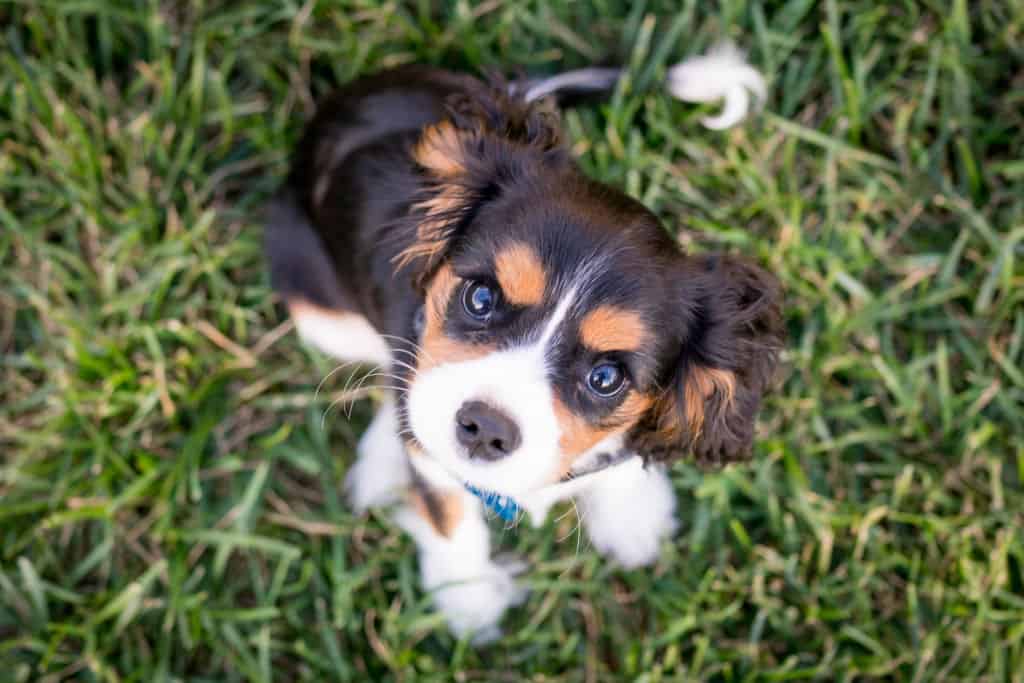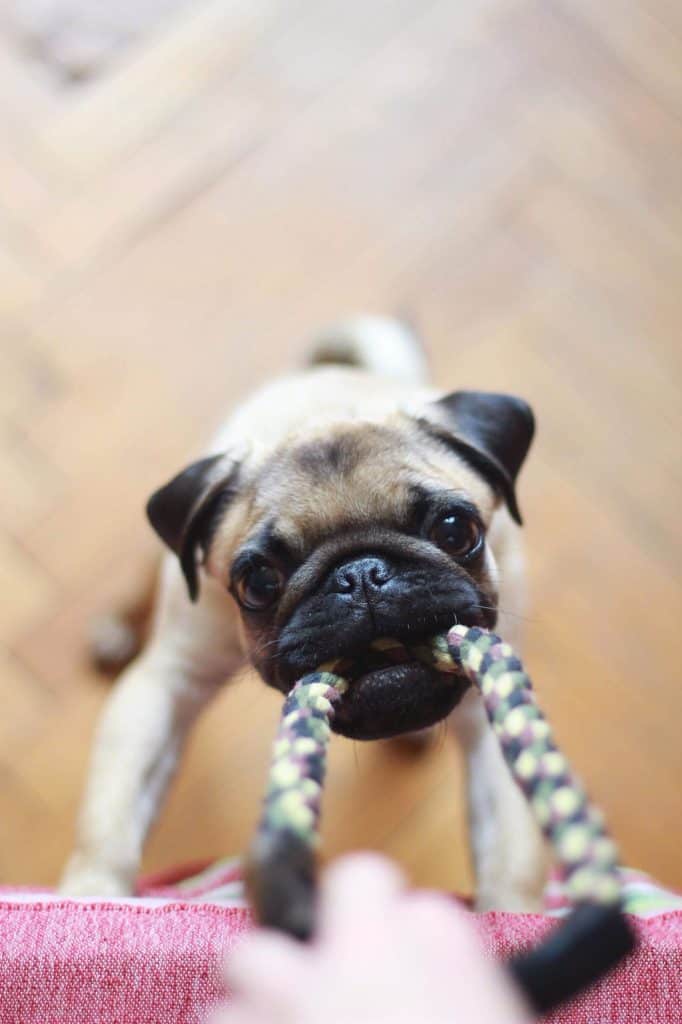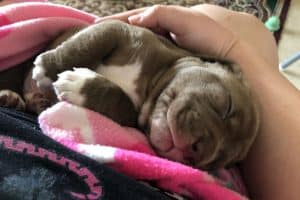Growling can be concerning when you get a new dog. Puppies show this behavior often, which can be puzzling to some dog owners.
For the most part, growling is very typical during play, especially if they’re happy for you to take the toy away. Puppies will usually play-growl and may even bark occasionally. However, some growls will be aggressive and usually sound quite different from playful ones.
Knowing your dog’s personality and the way they communicate will help you distinguish between the dog being aggressive and when they are just playing. And if your cat is toy-growling, visit this article.

Why Do Pups Growl at Their Toys?
The majority of the time, it’s just a harmless play growl. Low, calm, and deep are what they sound like. They’re simply having fun if their tail is up and relaxed. My dog used to do this and growl louder when I touched his side while playing, but it’s all in good fun.
Many new pet owners might not know this, but a puppy growling at a toy can be seen as an early exercise in setting boundaries. Just like they test their physical limits with play-fighting, they explore their vocal range with toys.
When a puppy growls during toy play, it’s often a sign they’re practicing vocalizations they might use as adults during real territorial or playful disputes.
Most dogs growl while playing. However, there are exceptions and will depend on the dog’s personality, amount of training, as well as their breed.
During playtime, one of our puppies used to bark and growl. We attempted to learn their vocalizations and then piece together what they were trying to communicate. It wasn’t an angry growl, and he was simply happy that someone was playing tug of war with him.
How to Tell if the Puppy Is Being Aggressive or Just Playing?
The reason for the growl will vary depending on the sort of growling. You should be able to tell which type from the body language and tone of the growl. It can be a playful growl, attention-seeking, aggressive, warning, and so on.
Growling with teeth and a snarl is typically aggressive. Growling as his buttocks are in the air and he is in a playing stance is a whole different experience. There will, however, be several exceptions.
My dogs growl and show their teeth in amusement, but it’s clear he’s having fun. Aggressive growling is distinct, deeper, and intimidating. A play growl has a lighter or softer tone. Huskies wrinkle their noses, but their ears do not retract, implying that they are acting or playing.
I’d be concerned about resource-guarding if he clenches his teeth and becomes rigid. I wouldn’t discourage it during play, but you might work with him on “dropping it” in exchange for a reward to ensure it’s not a resource-guarding concern.
Like individuals, you must understand their personalities and how they learn by their body language and tone of voice. Older dogs, having had years of interaction with various toys and humans, might growl as a nostalgic throwback to their puppy days, reminiscent of early play sessions.

How Do You Deal With a Toy-Aggressive Puppy?
The first thing to remember is never to correct or punish a dog for growling. Instead, you’d like your dog to notify you before becoming aggressive. You want a warning since you might not see the indicators of a bite approaching without the growl.
When they are uncomfortable or frightened, they may frequently growl as a warning. If you prevent them from growling, the warning signal is lost, and the dog will progress to the next stage of behavior, which could be biting.
It’s much better to have a dog that lets you know they don’t like something by growling than by biting.
With directions like “take it” and “drop it,” playing tug of war is an excellent method to improve impulse control. Growling is best approached by practicing those impulse commands, especially with pups. You’d want to practice waiting, dropping toys, leaving them, and staying in place.
For dogs who seem to have a particular attachment to certain toys, rotating them out can be an effective way to reduce possessive behavior and offer fresh stimulation.
Some dogs have eccentricities that cause them to make distinct noises, which isn’t necessarily due to anger. It is more important to consider the dog’s state and maintain constant control through trustworthy redirection, command, and knowing your dog’s temperament.
Sometimes, it’s ok to let them win. It enhances their self-esteem but should not cause them to become aggressive in other areas.
How to Train a Puppy to Stop Growling at Toys?
Just like you can train a dog from peeing on things, you can train them when growling and biting.
However, when dealing with puppies, try encouraging the growling while acting as if they’ve wounded you when they nibble or nip. Growling isn’t bad, and it’s best not to stop it because this is how they communicate with you.
You want them to feel at ease being noisy and growling, so there’s a warning before a bite, but they also need to understand that biting is wrong. When they growl, you’ll remark, “Good boy,” and when they nibble, you’ll shout, “OUCH!”
If they become overly aggressive in leaping up or jumping on you, disengage to demonstrate that they must control their mouth for play to continue. Training your dog is essential to get the dog to like you and respect you.
Do Puppies Eventually Stop Growling?
Growling can convey various messages, such as playful, warning, aggressive, or attention-seeking. Most older dogs continue to growl, especially when playing tug of war or other similar games with them, but sometimes it may lead to a more severe issue, such as resource guarding.
My dogs regularly play-growl, and I don’t discourage it since I want them to communicate with me. They may growl sometimes, but their body language indicates they are relaxed and enjoying themselves.
If you’re considering trying to stop your dog from growling, consider why you’d want to prevent your dog from communicating with you. If there is no sign of hostility, there is usually no need to intervene.
However, if your dog frequently growls at you and others, it may signal a behavioral or health issue. If you’re unsure how to handle this, you should consider having your dog evaluated by a behaviorist.
FAQs
How to get a puppy to release a toy?
You may train your puppy to release toys with or without a treat. When using a treat, you can just shove a treat in their mouth and say, “drop it!” when they have a toy in their mouth. They’ll quickly realize they’re getting a nice treat if they drop whatever they were doing when you said the word. You may also train the “Give” command using positive reinforcement.
To train them without a treat, you’ll need two toys. When they have a toy in their mouth, show them the other one, and when he opens their mouth to drop the present object, tell them to “drop it!” and hand them the toy you are holding. Make sure the dog equally values both toys.
Why is my dog possessive of toys?
Being possessive of toys is sometimes an indication of resource guarding. Resource guarding is a natural survival characteristic in dogs. It’s a good idea to focus on prevention with your dog and to know how to spot and address an issue if it arises.
Should you let your puppy play aggressively?
While there’s nothing wrong with a bit of growling during play if a puppy shows signs of aggression and resource guarding, it’s essential to train your dog using commands such as “drop it” or similar. Puppies may grow out of it, but teaching them may help prevent resource guarding.
Why do dogs shake their toys?
Toy shaking is a common occurrence among dogs, particularly pups. It usually does not mean future aggression, and it’s just how they play. It is prevalent in Terriers. While it may not be a concern in a dog’s behavior, depending on the type of toy, it might become dangerous at times.
Alex, a passionate animal lover, has experience in training and understanding animal behavior. As a proud pet parent to two dogs and three cats, he founded AnimalReport.net to share insights from animal experts and expand his knowledge of the animal kingdom.




